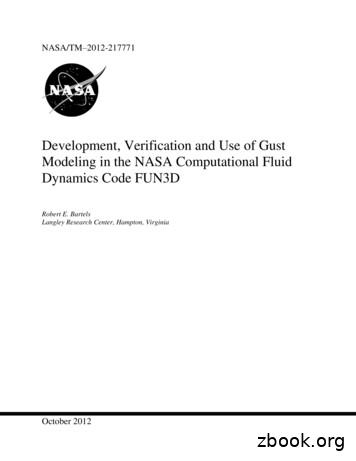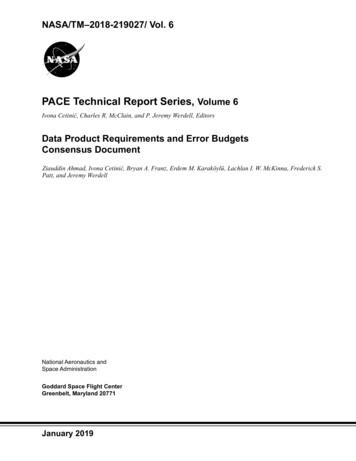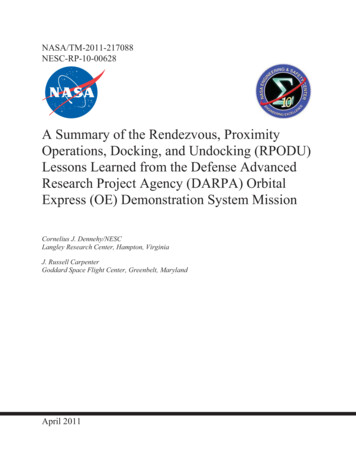Space Technology - NASA
National Aeronautics and Space AdministrationSpace TechnologyGame Changing DevelopmentMonthly HighlightsNovember-December 2013Slosh Team Readies for Important LaunchAfter a successful demonstration flight in September,the next Orb-1 mission is scheduled to launch on anAntares rocket in January 2014 as part of the NASACommercial Resupply to Station contract.Project. “Now that rockets are bigger and are goingfarther, we need more precise data. Most of themodels we have were validated under 1 g conditionsContinued on page 2.The first operational delivery flight to actually carry supplies and experiments,Orbital Sciences Corporation’s unmanned cargo freighter Cygnus will loft approximately 3,217 pounds (1,459 kg)of science equipment, spare parts andsupplies to the International Space Station (ISS) for NASA.Along for the ride with this payload willbe the ISS Fluid Slosh experiment, aSpace Technology Mission Directorate,Game Changing Development Programproject dedicated to improving our understanding of how liquids behave whenthere is little to no gravity.“Modern computer models try to predicthow liquid moves inside a propellanttank,” said NASA’s Brandon Marsell,co-principal investigator on the SloshImage Credit: NASANASA’s Brandon Marsell, co-principal investigator on the Slosh project,displays the Fluid Slosh experiment.
Slosh Launchthis experiment will gather sets the foundation for alllong-term space flight involving liquid fuels. It was anhonor to be a part of something that will have such agreat impact in the exploration of space.”Continued from page 1.on Earth. None have been validated in the surfacetension-dominated microgravity environment of space.”Rich Schulman, an FIT student involved in the Sloshexperiment since its beginning, said, “One huge benefit for the students working on this project is seeingfirsthand the requirements for developing a payloadfor the ISS. Having gone through this process successfully, the students involved can effectively buildfuture payloads or projects at the same standard.”The proposed research provides the first data set fromlong duration tests in zero gravity that can be directlyused to benchmark computational fluid dynamicsmodels, including the interaction between the sloshing fluid and the tank/vehicle dynamics.To explore the coupling of liquid slosh with themotion of an unconstrained tank in microgravity,NASA’s Launch Services Program (LSP) teamed upwith NASA’s Game Changing Development (GCD)Program, the Florida Institute of Technology (FIT),and the Massachusetts Institute of Technology (MIT)to perform a series of slosh dynamics experiments inthe ISS using the Synchronized Position Hold EngageReorient Experimental Satellites (SPHERES) platform.The SPHERES test bed provides a unique, free-floatinginstrumented platform on ISS that can be utilized in amanner that would solve many of the limitations of thecurrent knowledge related to propellant slosh dynamicson launch vehicle and spacecraft propellant tanks.“It was a complex and detailed process to bring thisconcept to fruition,” said Charlie Holicker, an FIT student who worked on the physical design of the experiment and aluminum machining. “The data thatImage Credit: NASACygnus spacecraft shortly before attachment to ISS onSeptember 29, 2013.FOST Technology Receives Potential 750K Funding AwardNASA and its partners are currently developing anew generation of biologically inspired, forwardosmosis (FO) membranes that have improved organic rejection over commercially available membranes. The new classes of membranes havesuperior organic rejection, specifically urea rejection, over commercially available membranes.development of FOST technology for use asa gray water recycling system. The award isthrough the U.S. Army Research Developmentand Engineering Command (RDECOM) and TankAutomotive Research, Development, and Engineering Center (TARDEC).Under the Space Technology Mission Directorate’sGame Changing Development Program, thisactivity has a potential funding of 750K forNext Generation Life Support’s FO research over2 years.In October, Michael Flynn, lead for ForwardOsmosis Subsystem Treatment (FOST) technology advancement at NASA’s Ames ResearchCenter, received confirmation of an award for2
Legs Are Next forNASA’s FavoriteHumanoidSourced from NASA News ReleaseNASA engineers are developing climbing legs for theInternational Space Station’s robotic crewmemberRobonaut 2 (R2), marking another milestone in spacehumanoid robotics.The legless R2, currently attached to a support post,is undergoing experimental trials with astronautsaboard the orbiting laboratory. Since its arrival at thestation in February 2011, R2 has performed a series oftasks to demonstrate its functionality in microgravity.These new legs, funded by NASA’s Human Explorationand Operations and Space Technology mission directorates, will provide R2 the mobility it needs to helpwith regular and repetitive tasks inside and outsidethe space station. The goal is to free up the crew formore critical work, including scientific research.NASA engineers have built the legs and R2 will bereceiving them early next year. The new legs aredesigned for work both inside and outside the station,but upgrades to R2’s upper body will be necessarybefore it can begin work outside the space station.R5, next in NASA’s Robonaut series of robots, willdebut later this month when it competes in the Defense Advanced Research Project Agency’s (DARPA)Robotics Challenge. During the challenge, robots willdemonstrate capabilities to execute complex tasksin dangerous, degraded, human-engineered environments. Competing teams are expected to focus onrobots that can use standard tools and equipmentcommonly available in human environments, ranging from hand tools to vehicles, with an emphasis onadaptability to tools with diverse specifications.Image Credits: NASANASA’s Robonaut 2 is shown with the newly developed climbinglegs designed to give the robot mobility in zero gravity. R2’snew legs are ready to head to space early next year.3
Next Generation Life Support ProjectHosts Dr. Lind SeminarNASA Space Technology Mission Directorate’s GameChanging Development Program’s Next GenerationLife Support (NGLS) project hosted a seminar given byDr. Mary Laura Lind of Arizona State University (ASU)in July. Dr. Lind is one of 10 recipients of the 2013Space Technology Research Grant for NASA’s EarlyCareer Faculty efforts. The grants are designed toaccelerate the development of technologies originating from academia that support the future scienceand exploration needs of NASA, other governmentagencies and the commercial space sector.“We are currently using forward andreverse osmosis processes as partof an effort to develop an alternativewater processor for spacecraftcabin water recovery. Advancesin membranes will increase theperformance of systems.”NASA seeks to dramatically improve state-of-theart systems in water recovery and management forhuman health and habitation in space flight and travel,and Dr. Lind’s research responds to this technologyroadmap challenge under the Environmental Controland Life Support Systems.Dr. Mary Laura Lind.fleet, the need to minimize use of ground-based resources is a higher priority.During the seminar, entitled “Nanocomposite membranes to recover water from urine,” Dr. Lind discussed results from the first year of research on improving water systems for space vehicles under theEarly Career Faculty grant. The efforts at ASU arefocused on developing advanced corrosion-resistantpolymer membranes through which wastewater canbe recovered and filtered for reuse.Dr. Lind’s research seeks to increase the amount ofexploration wastewater that can be reused by developing a new class of corrosion-resistant molecularsieve inclusion nanocomposite (MoSIN) membranesthat effectively recover water from urine and urinebrine solutions through osmotic processes.Current osmotic processes—both reverse osmosis(RO) and forward osmosis (FO)—offer the potentialto increase water recovery from wastewaters consisting of raw urine, pretreated urine, and urine brines.Unfortunately, commercial RO and FO membraneshave key limitations for water recovery processes.These membranes succumb to rapid degradationin the presence of acidic pretreated urine and urineThe current water recovery system on the International Space Station uses a distilling and filteringprocess that recovers 70% of the wastewatergenerated. However, the remaining 30% of the wateris brine that must be stored for disposal later on, andthe current system is dependent upon resupply missions. Because NASA has retired the space shuttleContinued on page 5.4
Composite Cryotank MakesCross-country TripNASA needs an affordable, lightweight vehicle forpublic outreach opportunity for Boeing and NASA togreater payload capability to enable future explodisseminate the information about this exciting techration missions. Composite cryotanks could lead tonology and start the dialog about future possible aprocket propellant tanks that achieve greater than 30%plications.The 2.4-m tank also made a stop at NASA’sweight savings and 25% cost savings compared withLangley Research Center in Hampton, Va., for thethe state-of-the-art, The Composite Cryotank TechnoloGame Changing Development Program Office’s Angies and Demonstration (CCTD) project has producednual Review.the largest automated fiber placement, out-of-autoclave, compositetank ever manufactured. The 2.4-mcomposite cryotank represented amajor element of the acceleratedbuilding block approach that hasinformed the design, fabricationand testing of the 5.5-m article.The tank was shipped from Huntsville, Ala., to Kissimmee, Fla., to bedisplayed within the Boeing boothas part of the Defense Manufacturing Conference (DMC) exhibit.The DMC is the premier nationalconference that brings togetherleaders from government, industry, and academia aimed at addressing advanced manufacturingImage Credit: NASAtechnology. This was an excellentComposite cryotank at the DMC exhibit.through solution casting, spray deposition, and latexfilm formation. During the seminar, Dr. Lind describedthe optimized deposition methods and presentedcharacterization data of thin film properties and waterbarrier performance.Dr. LindContinued from page 4.brines, and they are not a sufficient barrier to smallorganic compounds commonly found in urine.“We can form water-barrier thin films of polymers onporous supports through solution and latex depositionmethods,” Dr. Lind said during her presentationconclusion. Year 2 research goals include synthesisof MoSIN membranes and performance testing withideal, model solutions.Dr. Daniel Barta, Project Manager of NGLS, was particularly interested in this funded activity. “We arecurrently using forward and reverse osmosis processes as part of an effort to develop an alternativewater processor for spacecraft cabin water recovery.Advances in membranes will increase the performanceof systems.”Advanced materials that successfully increase thereusable amount of water retrieved in space havethe potential to decrease payload, extend the timehumans can sustain activities beyond low-Earth orbit,and are a method of resource recovery crucial to thefuture of interplanetary travel.Dr. Lind’s initial year of research holds exciting promisetoward improving membrane technology. Investigations have included deposition methods of waterbarrier polymeric thin films onto porous substrates5
Game Changing’s2013 AnnualProgram ReviewImage Credit: NASAThe Game Changing Development Program held its2013 Annual Program Review (APR) December 10-12 atNASA’s Langley Research Center. Associate Administrator(AA) for NASA’s Space Technology Mission DirectorateMichael Gazarik, Deputy AA for Programs James Reutherand Deputy AA for Management Dorothy Rasco, as wellas other NASA stakeholders, were in attendance. Projectmanagers from across many different centers traveledto the APR to report on their projects’ major milestones,accomplishments, technology transfer and educationand public outreach as well to give a look-ahead for FY2014. In conjunction with the APR, the 2.4-m compositecryotank (shown in the background) was at NASALangley for display. In addition to presentations, projectmanagers shipped hardware and posters for the APRexhibit and participated in video interviews.Image Credit: NASAMembers of the Advanced Radiation Protection team discussspace weather during the APR.Image Credit: NASAImage Credit: NASAThe 2013 GCD Annual Program Review kicked off Dec. 10 atthe National Institute of Aerospace.Project managers Bill Bluethmann (left) and John Lytle visitthe exhibit tables during a break.6
Game Changing Education and Public OutreachSeveral Game Changing projectssupported the Space TechnologyMission Directorate exhibit during theMaven Launch at NASA’s KennedySpace Center in November. Membersof the Slosh team (pictured) and InSpace Research Utilization staffedexhibits at the Saturn V building, andAdvanced Space Power Systems andWoven TPS sent exhibits. During theexhibits, NASA staffers engaged visitors about the mission of SpaceTechnology. The event drew morethan 30,000 people.Image Credit: NASAMembers of the GameChanging DevelopmentProgram Office participated in NASA Langley’sannual chili cook-off fundraiser for the CombinedFederal Campaign (CFC).Team members SteveGaddis, Arna Majcher,Jessica Woods-Vedeler,Bob Hodson, Parth Punjabi,Rob Lowe, Dawn Stewartand Amy McCluskey formed The Bazinga! Team andserved “Big Bang Chili.”The team raised 140 forthe CFC.Image Credit: NASAG!nOameFor more information, contactAmy McCluskeyCommunications ManagerGame Changing Development Program OfficeNASA Langley Research ://gameon.nasa.gov7
Space Technology Mission Directorate, Game Changing Development Program project dedicated to improving our un-der standing of how liquids behave when there is little to no gravity. “Modern computer models try to predict how liquid moves inside a propellant tank,” said NASA’s Brandon Marsell, co-principal investigator on the Slosh Project.
2016 nasa 0 29 nasa-std-8739.4 rev a cha workmanship standard for crimping, interconnecting cables, harnesses, and wiring 2016 nasa 0 30 nasa-hdbk-4008 w/chg 1 programmable logic devices (pld) handbook 2016 nasa 0 31 nasa-std-6016 rev a standard materials and processes requirements for spacecraft 2016 nasa 0 32
Jan 10, 2012 · The NASA STI program provides access to the NASA Aeronautics and Space Database and its public interface, the NASA Technical Report Server, thus providing one of the largest collections of aeronautical and space science STI in the world. Results are published in both non-NASA channels and by NASA in the NASA
The NASA STI program provides access to the NASA Aeronautics and Space Database and its public interface, the NASA Technical Report Server, thus providing one of the largest collections of aero-nautical and space science STI in the world. Results are published in both non-NASA channels and by NASA in the NASA
The NASA STI program provides access to the NASA Aeronautics and Space Database and its public interface, the NASA Technical Report Server, thus providing one of the largest collections of aero-nautical and space science STI in the world. Results are published in both non-NASA channels and by NASA in the NASA STI Report Series, which includes
The NASA STI program provides access to the NASA Aeronautics and Space Database and its public interface, the NASA Technical Report Server, thus providing one of the largest collections of aero-nautical and space science STI in the world. Results are published in both non-NASA channels and by NASA in the NASA STI Report Series, which includes
provides access to the NASA Aeronautics and Space Database and its public interface, the NASA Technical Report Server, thus providing one of the largest collections of aeronautical and space science STI in the world. Results are published in both non-NASA channels and by NASA in the NASA STI Report Series, which includes the following report types:Cited by: 11Page Count: 37File Size: 408KBAuthor: Corneli
The NASA STI program operates under the auspices of the Agency Chief Information Officer. It collects, organizes, provides for archiving, and disseminates NASA’s STI. The NASA STI program provides access to the NASA Aeronautics and Space Database and its public interface, the NASA Technical
NASA Aeronautics and Space Database and its public interface, the NASA Technical Reports Server, thus providing one of the largest collections of aeronautical and space science STI in the world. Results are published in both non-NASA channels and by NASA in the NASA STI Report Series, wh























